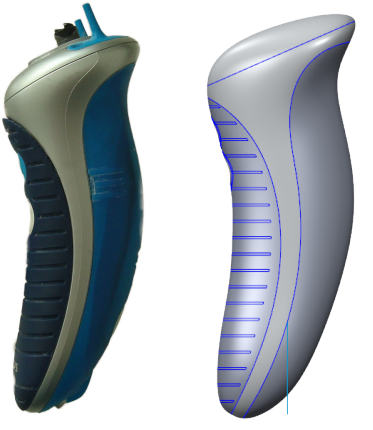After several years of expired maintenance it's time to reactivate or make the jump to Solidworks. As in independent freelancer, staying up to date with one software is tough enough financially. I'd love to be running both ProE and Solidworks, but I just can't afford it. I've talked with a lot of people, done some SW demos, and read a lot of the comparison debates here and in other online forums. For the type of work I do - mostly injection molded consumer products (lots of surfacing) - it sounds like I would be better off sticking with ProE. Obviously there are many different opinions, and there is great work being done on both systems. But when I talk to guys who have a lot of experience with both systems, the general consensus seems to be that ProE is still more powerful than SW when it comes to building complex and easily modifiable surface models. Seems like this has a lot to do with SW dropping references....at least that's what I hear.
While I want to work with the software that gives me maximum functionality, my main priority is to be as marketable as possible as a designer. The general trend in my line of work seems to be moving toward SW, and I certainly see more demand for SW designers. After a few demos, I was beginning to lean towards SW. Workflow seems very easy and I really love the "multiple bodies in a single part" function - what a great way for designing overmolded parts.
Then I started looking into the freestyle feature that's included with Creo 2.0. I've done a little looking around at videos and forum reports on this tool. But I wanted to get more feedback from anyone that might be giving this feature a lot of use. It looks like a game changing tool, but how functional is it? I've really only seen videos of very cool surfaces being created very quickly, but what then? How well does a freestyle feature integrate with with other features like extudes, revolves, traditional boundary surfaces, etc? Can we control size of the freestyle feature in any way? Can we add freestyle features to existing geometry (and reference existing geometry). For example, if I modeled a head shape using boundary blends, could I use freestyle to add details like a nose? Will the freestyle feature update if the parent surfaces are modified? Can we build onto existing freestyle features with parametric extrudes, revolves, etc (referencing freestyle feature)? Problems with offsetting freestyle surfaces? How well does this feature really fit into creating a fully finished "toolable" solid part? What are the limitations?
Yes, I have lots of questions. Thanks for any feedback guys!
Mike
While I want to work with the software that gives me maximum functionality, my main priority is to be as marketable as possible as a designer. The general trend in my line of work seems to be moving toward SW, and I certainly see more demand for SW designers. After a few demos, I was beginning to lean towards SW. Workflow seems very easy and I really love the "multiple bodies in a single part" function - what a great way for designing overmolded parts.
Then I started looking into the freestyle feature that's included with Creo 2.0. I've done a little looking around at videos and forum reports on this tool. But I wanted to get more feedback from anyone that might be giving this feature a lot of use. It looks like a game changing tool, but how functional is it? I've really only seen videos of very cool surfaces being created very quickly, but what then? How well does a freestyle feature integrate with with other features like extudes, revolves, traditional boundary surfaces, etc? Can we control size of the freestyle feature in any way? Can we add freestyle features to existing geometry (and reference existing geometry). For example, if I modeled a head shape using boundary blends, could I use freestyle to add details like a nose? Will the freestyle feature update if the parent surfaces are modified? Can we build onto existing freestyle features with parametric extrudes, revolves, etc (referencing freestyle feature)? Problems with offsetting freestyle surfaces? How well does this feature really fit into creating a fully finished "toolable" solid part? What are the limitations?
Yes, I have lots of questions. Thanks for any feedback guys!
Mike

